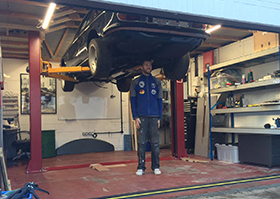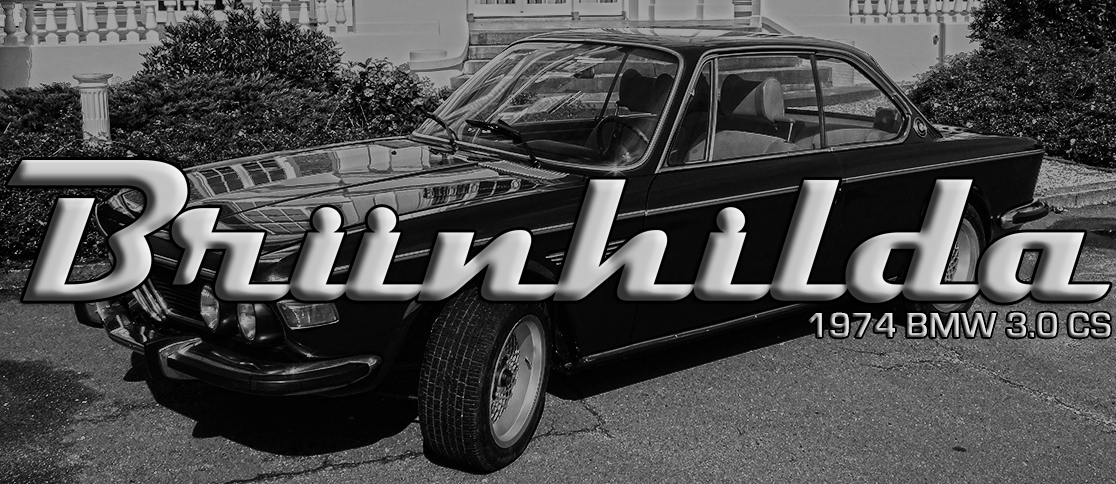
Brünhilda | Biography
As Brünhilda began her life as a BMW 3.0CSa Coupe, better known as the E9, I figured we’d best start with a small lesson in History. Subsequently we'll look further into Brünhilda's personal history, why the name and what the future might hold for her.
The E9 Family History
The year is 1968 and BMW is looking to replace the 2000C and CS models, which had been produced for the last 4 years as part of BMW’s Neue Klasse (New Class) range of cars. Lead designer Wilhelm Hofmeister has been put in charge and comes up with the first of the E9 coupe designs, the 2800CS, by increasing the wheelbase length to allow the engine bay to be long enough to fit the new straight-six engine (M30), while restyling the front of the car to resemble the popular E3 sedan. The rear axle, however, was left untouched and used the same parts as the lesser “Neue Klasse” models with initially using drums for the rear brakes.
After 3 years of production, the 2800CS was replaced by the 3.0CS (carburettor) and 3.0 CSi (injection) in 1971, which was a bored-out version to give a displacement of 2,986cc. The model came with a 4-speed manual or a 3-speed automatic gearbox. BMW further upgraded this car which was subsequently introduced as the 3.0CSL (The L standing for “leicht” / lightweight) in May 1972. The model was a homologation special built to make the car eligible for racing in the European Touring Car Championship and a total of 1,265 were built. The engineers basically stripped the car of any trim and soundproofing, and replacing the heavy steel doors, bonnet and boot lid with aluminium alloy replacements. Even the side windows were replaced with Perspex in order to reduce the weight by almost 300kg. It initially used the same 3 litre engine, although its capacity was increased to 3,003 cc in order to be eligible for the “over three litre” racing category. In 1973 a further increase was giving in displacement, pushing the engine to 3,153 cc (known as the 3.2 version). The final version of the CSL came in July that same year which included a full aerodynamic kit, including a large air dam, a roof spoiler and the famous “Batmobile” rear wing and produced 203 hp, quite the step up from the first model.
Although BMW appeared to be making bigger and bigger engines for the E9, the final variant of the car that was to be introduced came with a 2.5 CS in 1974, as a response to the 1973 oil crisis. With this they hoped buyers would still be interested as they could now get their hands on an E9 with a smaller, more economical engine.
In 1975 BMW stopped production of the E9 series all together and the model was replaced by the E24, the first of the 6 series. A total of 30,546 cars were made. Yet despite the termination of production, BMW would win the European Touring Car Championship with an E9 for each year from 1975 to 1979, be it with an even bigger engine (the famous 3.5CSL). The CSL was also the first car to be converted to “Art Cars”, one by Alexander Calder and the second by Frank Stella.
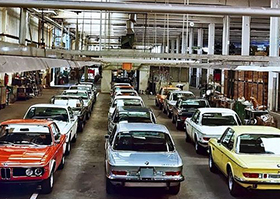
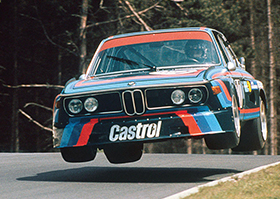
Brünhilda's History
Brünhilda was born on 24 July 1974 in Munich, Germany as a 3.0CSa (automatic) bearing the colour “Atlantik” blue with VIN number 4320293. She was exported the following week to the Belgian BMW importer Moorkens in Antwerp.
Unfortunately, the years that followed, including who her first owner was, remain a mystery for now. I’m trying hard to find out more information and any help is more than appreciated. What I do know is that she remained in Belgium and ended up in a Chateau somewhere in the Ardennes, where her owner kept her amidst his collection of Italian super cars. This particular owner gave her a bodywork restoration in what seems to have been the early 2000’s, before giving the car to his kids for them to learn how to drive in. A few modifications were added with the plan to take her rallying (including the addition of extra headlights).
From here the story goes that the mentioned owner also had an Austin Healey in which he participated in the Tulip Rally, the same rally my dad participated in with a friend of his. And since my dad's friend happened to drive the same car, they were invited to the man’s home residence. As part of the tour they ended up in the basement where they were shown the car collection. It was quickly pointed out that the BMW didn’t “fit in” amongst the classic Italian Ferrari’s, Maserati’s and Lamborghini’s. At this point a reasonable share of alcohol may be involved, but the owner agreed and made my dad an offer to buy the car off him. Perhaps not the typical “barn-find” story, but that’s how we ended up with a BMW 3.0CSa in our family.
At first the car was stored next to the Austin Healey, where my brother and I learned to drive it as we went up and down the 400-meter driveway. In 2007 the decision was made to get the car road certified and we drove it to the local testing station, but she never made it there. Somewhere along the way the oil lubrication system inside the engine had clogged up and as a result one of the pistons seized, resulting in a catastrophic engine failure. Without much choice, work began on restoring the engine, while also taking care of the front end of the car now that we had easy access. Practically every part was replaced, including the support frame, shock absorbers and suspension, radiator, brakes, a new coat of rust protection and finally fresh paint for the engine bay. Sadly, the progress came to a halt when I moved to the USA in 2011 and the car ended up in long-term storage.
Skip ahead a few years to 2018 when she was pulled from under her layer of dust and shipped to the UK where I now lived, with a new attempt at getting her road worthy again. While being kept in a family member’s garage, the electrical work was completed and after 12 years of silence, she was roaring loudly again as we got the engine running over Christmas that same year. However, progress once again was put on halt as I moved to a new house and began preparing my own garage for her arrival.
It is now early 2020 and after many years, Brünhilda is finally home.
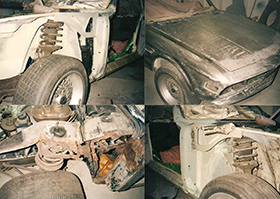
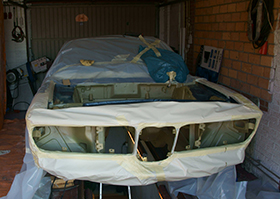
Why the name Brünhilda
In my eyes a (classic) car should always be addressed as a ‘she’ and with that comes a female name. Choosing a name comes with a few rules in my regard; It has to match the car’s country of origin (Germany), start with the same letter as the colour (Blau/blue), and match the character of the car. With that in mind, is there any better name than that of the German Valkyrie “Brünhilda”?
Brünhilda will be carrying her name on the back of the boot-lip in the form of a custom-made name badge, along with a bobble-head figure of a Valkyrie behind the rear window.
Brunhild, also known as Brunhilda or Brynhild (Old Norse: Brynhildr, Modern German: Brünhilde), is a powerful female figure from Germanic heroic legend, often called “the paramount figure of Germanic legend”.
She finds her history in both the Norse and Germanic tradition. In the Norse tradition, Brunhild is a shieldmaiden or Valkyrie, who appears as a main character in the Völsunga saga and some Eddic poems treating the same events. In the continental Germanic tradition, where she is a central character in Wagner’s Nibelungenlied (ca. 1200), she is a powerful Amazon-like queen (similar to the Valkyrie). In both traditions, she is instrumental in bringing about the death of the hero Sigurd or Siegfried after he deceives her into marrying the Burgundian king Gunther or Gunnar. In both traditions, the immediate cause for her desire to have Sigurd murdered is a quarrel with the hero's wife, Gudrun or Kriemhild.
The name Brunhild in its various forms is derived from the equivalents of Old High German brunia (armor) and hiltia (conflict) and was first attested in the sixth century, for the historical Brunhilda of Austrasia, as Brunichildis. In the context of the heroic tradition, the first element of her name may be connected to Brunhild's role as a shieldmaiden. The most popular theory about the origins of the legendary Brunhild is that she originates from two historical figures of the Merovingian dynasty: Brunhilda of Austrasia, a Visigothic princess who married the Frankish king Sigebert I.
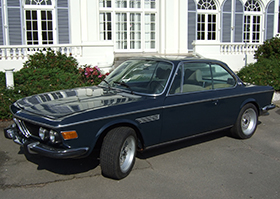

Brünhilda's future
So, what does the future hold for Brünhilda?
As much as that is a question that’s (almost) impossible to answer, what I do know it that she’ll receive many upgrades and modifications during the restoration process in order to make her the best she can be for classic rally competitions. Included in the work will be a full body "e-coat" treatment, roll-cage, custom wiring, 5-speed manual gearbox, triple Weber carburettors with Alpina airbox, Group 2 racing dashboard, Sparco bucket-type front seats, aerodynamic upgrades, and upgraded brakes and suspension. Plenty of work to do, all of which can be followed in the blog and video sections on this website.
